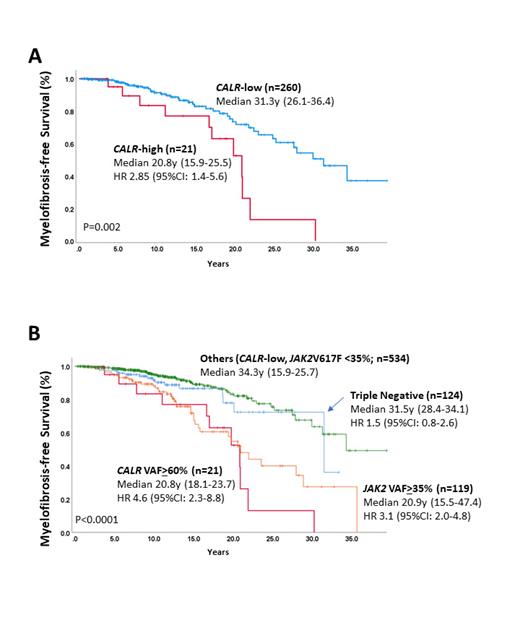Background. A mutation in calreticulin ( CALRm) is found in 30-35% of patients (pts) with Essential Thrombocythemia (ET). There are 2 main CALRm mutation types, Type 1/Type 1 like (T1) a 52bp deletion, and Type 2/Type 2 like (T2) a 5bp insertion. Other atypical mutations (T3) occur in a minority of pts. Recent study ( Guglielmelli P et al, BCJ 2023) in pts with myelofibrosis (MF) showed that higher CALR variant allele frequency (VAF) was associated with anemia at diagnosis and during FU, and to features of more advanced disease (CD34 + cell counts, ASXL1 mutation (mut), >2 mutated myeloid genes, and shorter leukocytosis-free survival.
Aim. To evaluate whether the CALRm VAF in pts with ET was associated with predefined major clinical outcomes: evolution to MF, transformation to acute leukemia (AML), thrombosis, major bleeding, and survival (OS).
Patients and Methods. Diagnosis of ET was strictly according to 2023 WHO and ICC to avoid mis-inclusion of prefibrotic MF. CALRm VAF was determined by capillary gel electrophoresis as the ratio (%) of areas under the curve of CALRm/ CALRm+ CALRwt. A panel of 45 myeloid neoplasm-associated genes was sequenced by NGS.
Results. A total of 281 CALRm ET pts were identified from CRIMM (Florence, I), Quebec MPN Research Group centers' (Canada) and Mayo Clinic (Rochester, US) databases; 152 (54%), 101 (36%) and 28 (10%) were T1, T2 and T3 CALRm, respectively. Overall FU was 8.6y (0.3-39.4), median survival was not reached. Rate of death at 10y, 20y and 30y was 8%, 15% and 25%. MF transformation occurred in 50 pts (18%), AML in 2 (0.7%), 25 pts (8.9%) died. A major thrombotic event before or at ET diagnosis occurred in 17 (6.0 %) pts (14 arterial and 3 venous), whereas 28 pts (10.0%) had >1 major thrombosis during follow-up (53.6% arterial, 46.4% venous). Major bleeding occurred in 19 pts (6.8%; 16 at or before diagnosis).
Ascertainment of correlation of CALRm VAF with predefined outcomes by continuous variable analysis (ROC curve) highlighted a significant correlation of VAF >60% with MF-free survival (MFS), with HR of 2.85 (95%CI, 1.4-5.6; P= .002. Fig. 1A). On the contrary, there was no impact of CALRm VAF as continuous variable on AML, thrombosis, bleeding and OS. We therefore used a threshold of >60% to compare main clinical and hematologic characteristics at diagnosis and outcomes during FU in pts categorized as CALR-high and CALR-low.
Of all pts, 21 (7.5%) harbored a VAF >60%; of these, 52%, 19% and 29% were T1, T2, T3, respectively, compared to 54%, 37%, 8% of CALR-low (P= .008). We found no difference in age, gender, constitutional symptoms, splenomegaly, arterial and venous thrombosis at diagnosis and FU, IPSET revised risk stratification, and bleeding events. Hemoglobin was lower (12.8 g/dL (8.4-14.0) versus 13.6 (10.1-16.0); P=.02), while leukocytes and platelets did not differ. The proportion of pts with additional mutations in myeloid genes was significantly greater in CALR-high pts compared to CALR-low (66.7% vs 30.2%; P=0.01), as it was the proportion of pts with >2 mut myeloid genes (25% vs 11.6%, P=0.04).
During FU, 52% of CALR-high pts (n=11) transformed to MF compared to 15% (n=39) of CALR-low (P<.0001); AML and death not differ. Anemia (<10g/dL) during the FU developed in 69% of CALR-high pts vs 18%, leukocytosis (>15x10 9/L) in 46% vs 8% and splenomegaly (greater than 5 cm from LCM) in 50% vs 12% (P<.0001 for all). The HR for anemia-free survival was 2.87 (95%CI, 1.3-6.3), for leukocytosis HR 3.71 (95%CI, 1.3-10.5) and splenomegaly HR 3.40 (95%CI, 1.2-9.2), all P<.01. MFS was significantly shorter in T1 (HR 2.0; P=0.04) or T3 (HR 2.7; P=0.03) using T2 as reference. Finally, we compared C ALR-mut, JAK2V617F mut and triple-negative (TN) ET pts. ROC analysis indicated a JAK2VAF >35% ( JAK2-high) as the best cutoff for shorter MFS. As in Fig. 1B, the MFS survival of CALR-high and JAK2-high was superimposable, and significantly shorter that in CALR/JAK2-low and TN pts.
Conclusions. A CALR VAF >60% in pts with ET is associated with greater risk and shorter time to MF progression, development of anemia and splenomegaly. Similar findings in JAK2-high pts reinforce that that accumulation of mutated CALR and JAK2 alleles, evident since diagnosis, is detrimental for evolution to post-ET myelofibrosis. Longitudinal studies after diagnosis might provide further information about the kinetics of allele accumulation.
Disclosures
Guglielmelli:Abbvie: Other: Other member of advisory board, speaker at meeting, Speakers Bureau; GSK: Speakers Bureau; Novartis: Other: Other member of advisory board, speaker at meeting, Speakers Bureau. Vannucchi:Roche: Honoraria; AOP: Honoraria; BMS: Honoraria; Abbvie: Honoraria; GSK: Honoraria; Novartis: Honoraria; Incyte: Honoraria.


This feature is available to Subscribers Only
Sign In or Create an Account Close Modal